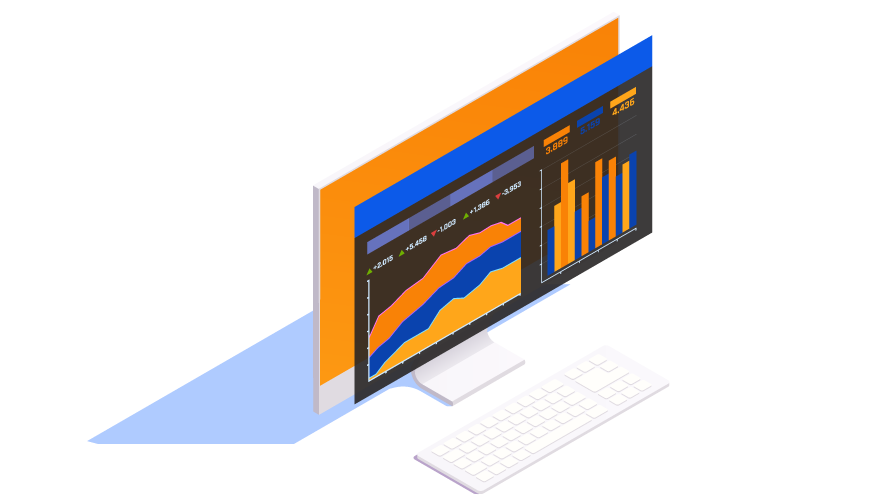
You may have heard about a market for Bitcoin and wondered, “What is bitcoin trading?” You’re not alone. Bitcoin trading can be a terrifying prospect if you’re not yet familiar with the basic terminology, the market itself, reading the trends, and building a trading plan. All of these things are key to becoming a successful Bitcoin trader, but fortunately, they’re not that complicated to learn either. This quick guide to how to trade Bitcoin can help.
Step 1: Get the Big Picture

The key to understanding how to trade Bitcoin means knowing more about the goal involved. The goal of Bitcoin trading is just like that of any other stock or commodity trading. The goal is to buy as low as possible and sell when they’re at a higher value. Many people mistake trading for investing. They’re really two different things. When you invest in Bitcoin, you’re buying it to hang on to for the long term – through the market’s ups and downs and hopefully building value along the way. Typically people choose to invest in Bitcoin because they thing this idea is going to mean big bucks in the long run. Many people mistake trading for investing. They’re really two different things. When you invest in Bitcoin, you’re buying it to hang on to for the long term – through the market’s ups and downs and hopefully building value along the way. Typically people choose to invest in Bitcoin because they thing this idea is going to mean big bucks in the long run. In the world of Bitcoin, this is known as the “HODL,” or simply keeping the currency as long as possible. When you’re trading, the goal is to use Bitcoin as a way to make profits in the short term. You buy and sell with the hope of turning a profit. You can do that when you predict movements in the price by looking at the wider industry and price graphs. Bitcoin is the perfect trading instrument for a few reasons. First, it’s incredibly volatile. It goes up and down on a regular basis, and if you can learn to predict that, it’s a huge win. Second, Bitcoin trading is open twenty-four hours a day and seven days a week. It’s not a traditional market. You choose to buy and sell when you want. More than that, though, Bitcoin is incredibly unregulated, so you can get started without a lot of issues.
Good traders spend lots of time and money, and there will be some ups and downs before you get the hang of it. Most traders subscribe to one of two methods: analysing the market based on the technology or analysing the market based on the fundamentals.
Step 2: Get Started

If you think you’re ready to invest in the wider world of Bitcoin trading, you’ll need to do four things to get started. The first is to actually to learn more about where to trade Bitcoin. You just open an account on one of the many Bitcoin exchanges. CEX.io is one of them, but there are a few others including eToro and Bitstamp. To actually begin trading, you will need to verify your identity. Once that step is complete, you can deposit money into your account, then buy or shortsell your first time.
Step 3: Understand the Methods Involved

Every trader has the same end goal, but for most, there are a few different ways to get there. One of the most popular is day trading. If you’re familiar with day trading in other markets, you’re familiar with it in Bitcoin too. The idea is that you complete multiple trades each day to get the profit from the tiny moves the market makes. Day traders spend tons of time looking at the screen trying to decide if now is the time to buy or sell, and the point of this strategy is to close everything up by the end of the day.
Scalping is another fairly popular type of Bitcoin trading. The timeline in scalping is even shorter than the one in day trading. It idea is to make a serious profit on a tiny price change. The smaller the profit, the more limited the risk, and the more advantage you have as a trader. Should you make this your guiding principal, you’ll make hundreds of trades in a given day.
Some subscribe to the swing trading method. In this school of thought, you’ll look at how the price cycles swing typically. You try to look at the beginning of the cycle, then enter your trade. When the movement dies, you take the profit and walk away. Swing trading can mean much bigger profits, but you have to continually see the big picture, not just what’s happening on the screen in front of you. You may hold your position for a few weeks before you get what you want.
Step 4: How to Analyse the Market

Traders using any of those methods try to predict Bitcoin’s pricing movement, and while no one can predict exactly what this cryptocurrency might do, just as with other markets, there are patterns and methods that may allow you to profit. Spotting those can mean amazing things. While no one only executes profitable trades, by the end of every trading session, you should still have an overall positive balance.
Some traders accomplish this goal through fundamental analysis. This is where you try to predict what the price might be by looking at the bigger picture involved. In Bitcoin, you’ll look at what’s happening with the currency, what technical developments are currently on the horizon, and any issues that might affect its success. The heart of this idea is that Bitcoin is a technology, and as such, relevant outside forces decide what will happen with the price.
Other traders, though, use technical analysis to try to understand the market. In that setting, you’re trying to predict the price by looking at market-based statistics. For example, you might look at price movements and trading volume. The goal is to see the patterns and trends in the price, then make a guess about what might happen in the future based on those patterns and trends.
While both methodologies are good, the reality is that there are never going to be guarantees when you trade anything. Instead, you simply go with what works for you and hope for the best.
Step 5: Tour the Terminology

If you’re going to trade, one of the first things you need to know and understand is the terms involved. Trading platforms and marketplaces are two of the most important. A trading platform is the site where you buy or sell your Bitcoin. Marketplaces are sometimes confused with platforms. These are places where both buyers and sellers can communicate with each other to make a trade.
Brokers are fairly common in the world of trading. They help you sell your Bitcoin, but they usually take a piece of the pie in the form of a fee.
You may also come up against the term “order book.” This is a complete list of buy orders and sell orders, and it can be viewed on any trading platform. Buy orders are better known as bids because people are literally bidding on the price at which to buy Bitcoin. Sell orders, though, are called asks, because they show the asking price from a seller to buy their Bitcoin.
The price of Bitcoin refers to the most recent trade on any given platform. There is no single price that everyone follows. The Bitcoin price in China, for example, may be quite different from the Bitcoin price in the United States. In some cases, you’ll see the price labeled high or low. That just tells you whether the price is at its highest or its lowest within the past 24 hours.
As you trade, you may also see the term volume. This is the number of Bitcoins that have been traded within the timeframe you specify. Volume is typically employed by traders to help understand how important a given trend is, and if traders think it is important enough, you’ll see a huge volume of trades. If you start to see a real price change, it’s essential that you check the volume, as the more people that are currently trading, the more important the trend might be.
A market order, which is sometimes referred to as an instant order, is set by the market, and it’s fulfilled at any price. You set the amount of Bitcoin you want to buy or sell and order the exchange to handle it right away. Then the platform on which you’re working matches you with a buyer or a seller. In some cases, it won’t just be one buyer or seller. Instead, it might be many people at several prices. It works like this. You try to buy ten Bitcoins. The platform looks for the cheapest seller, and it completes the order when it finds sellers available to fill it. Maybe you buy five of those at one price, three at another, and the final two at yet another. Until the order is filled, you don’t stop buying or selling Bitcoins.
A limit order is another term with which you may become familiar. In this type of order, you buy or sell your Bitcoin at a certain price on which you’ve decided. If you want to buy Bitcoin at $9,000 a coin, for instance, you may never end up buying as many as you intended because no one will sell them at that price, so limit orders can be helpful, but they can also be quite frustrating.
A stop-loss order is a way to minimise your losses. It allows you to set a certain price you want to sell at in the future should the price begin to drop. For example, maybe you set a stop-loss order when they lose three percent of their value. Then once that happens, it automatically turns into a market order, and they will be sold should that event happen.
Another term you might see is a maker fee. Exchanges want people to make trades because that betters the market. So, if you create a new order, but it can’t be matched, you’re being a market maker, and thus you pay lower overall fees. Along with maker fees, though, come taker fees. Takers literally remove business from the market because they’re filling those orders, so they pay higher fees.
Step 6: Avoid the Mistakes

As any guide to Bitcoin trading will tell you, there are many mistakes traders make when they first get started, but understanding that they’re out there is one way to avoid the problem. Mistakes are more complex than most people realize. They don’t involve things like where to trade Bitcoin or when to trade it. Instead, they can be more complex. One of the biggest mistakes? Too much risk. If you aren’t comfortable losing it, you don’t want to risk it. Take a serious look at how much you feel comfortable losing, then play the market. In some cases, you could lose absolutely everything you’ve placed there, and while that’s the last thing you want to happen, it’s certainly possible. Invest comfortably, and you’ll never make that mistake.
Another fairly common mistake is not trading with a plan in place. Some people enter the trading arena just to do it, so they don’t know when to enter a trade and when to walk away. Set some clear goals for yourself before you ever get started, and create some barriers (like stop-losses) so you know what to do before the trade ever happens.
Fear and greed control many traders, and that’s one of the reasons people end up making big mistakes. You may get worried about the market and close your trade out of fear. You might decide you’re missing out and get greedy, too. In either case, you’re playing the market wrong. Don’t let emotions rule your trades. Make sure you make the rules for every trade before it happens.
The other big mistake you can make? Not learning your lessons soon enough. If you haven’t made a successful trade, or you have, there’s a lesson to come out of that. Make sure you get what it’s trying to tell you.
Ready to Trade?

Bitcoin trading may seem fairly complex at first, but the reality is that understanding the question “What is Bitcoin trading?” is pretty simple once you have all of the information you need. The trick is in paying attention so you can make profitable trades on a daily basis. Working through a guide to Bitcoin trading like this one can help, but what will help the most is to get started.